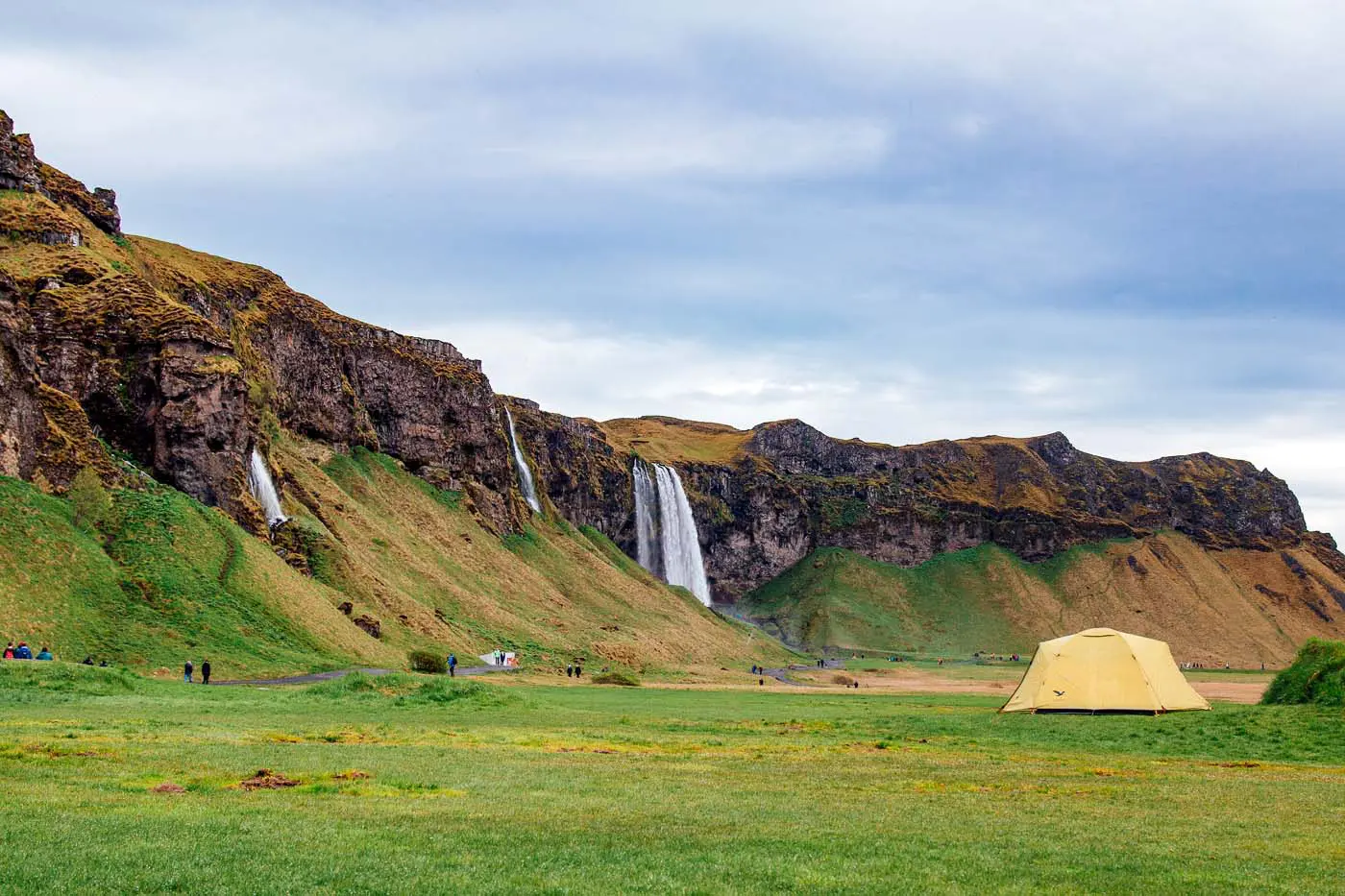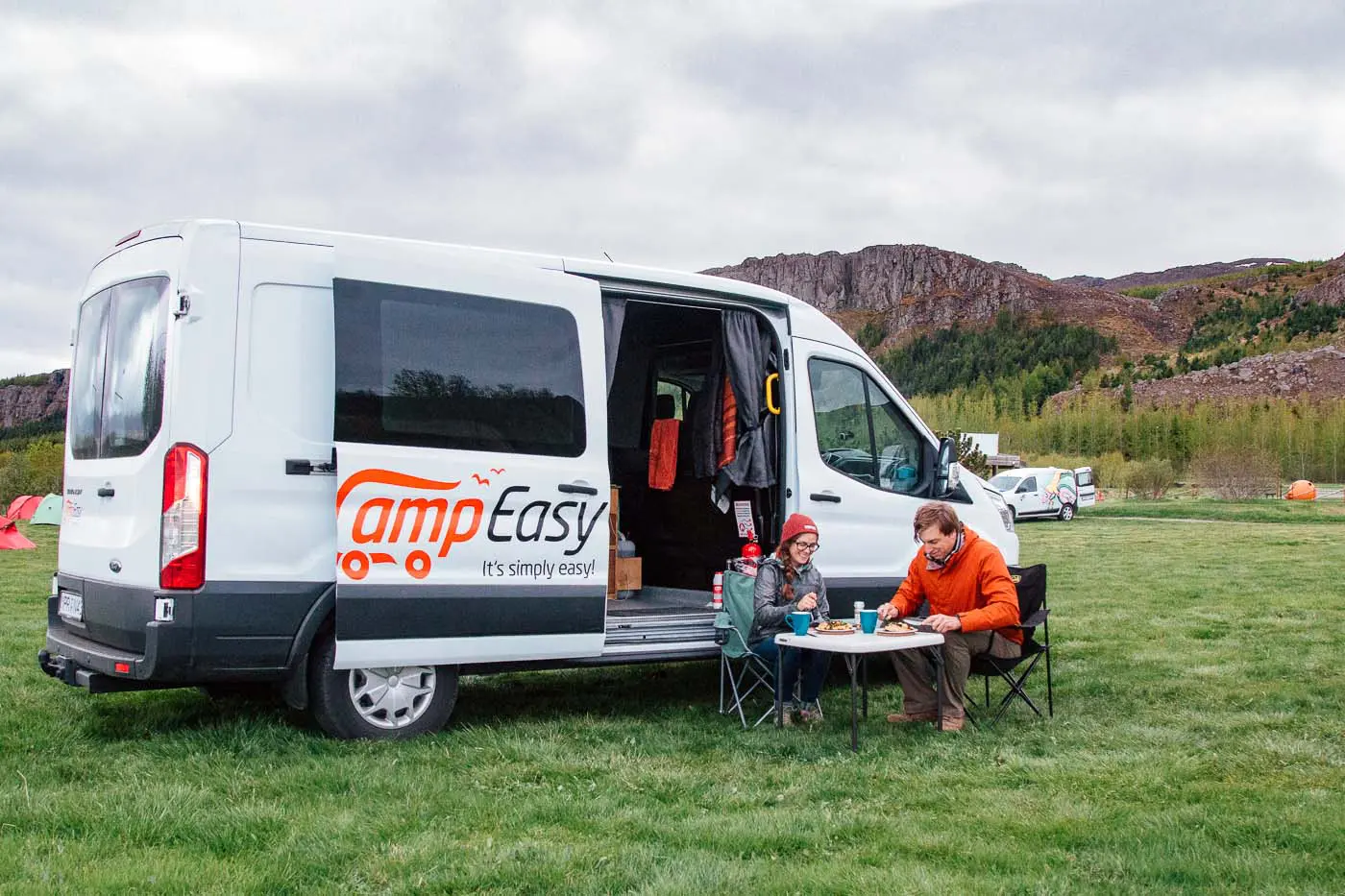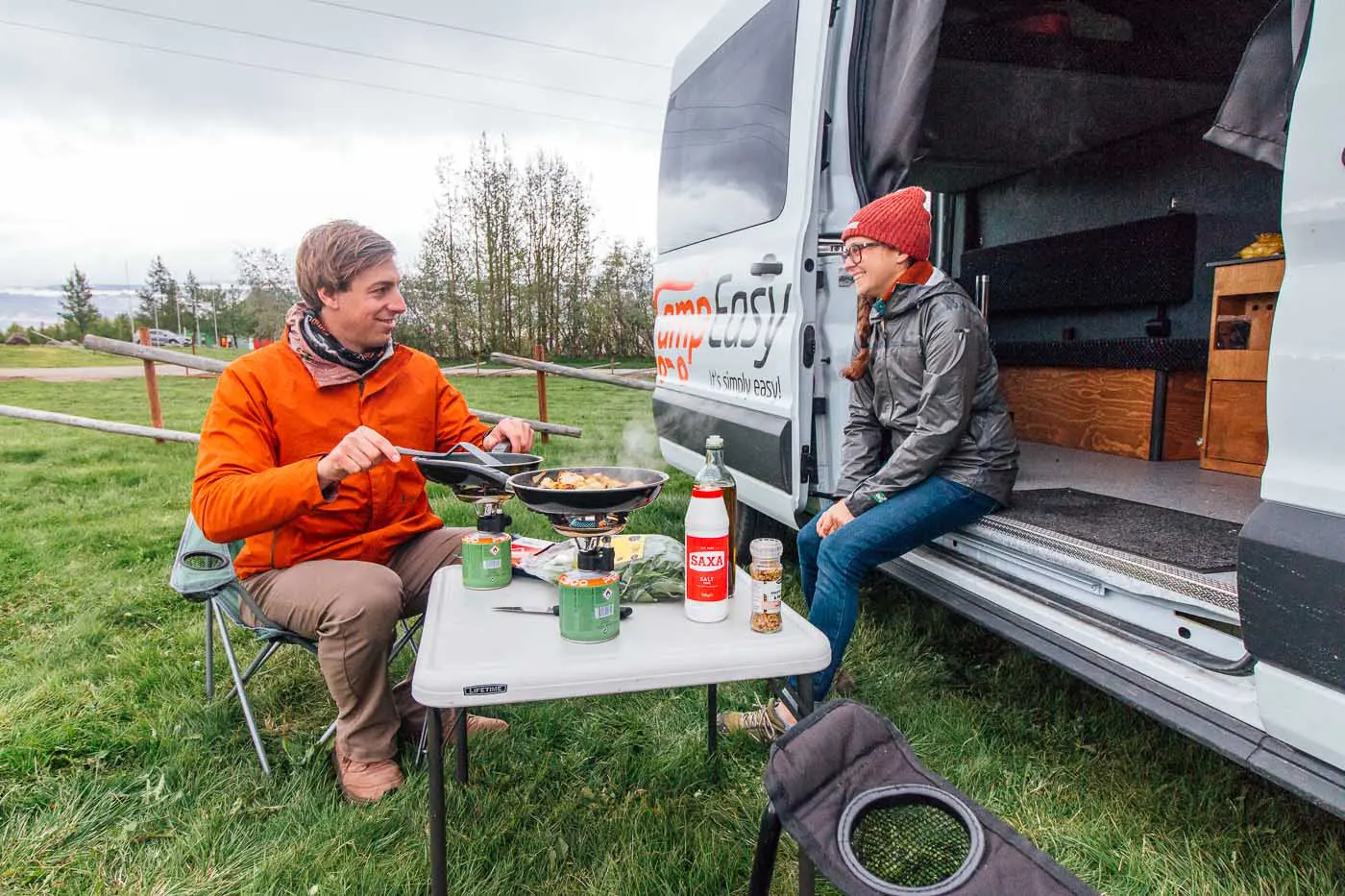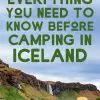Everything You Need to Know About Camping in Iceland
This post may contain affiliate links.
Camping in Iceland is one of the best ways to immerse yourself in the country’s rugged, natural beauty. If you want to really connect with the land, there’s no better way than to spend a few nights out under the stars (or northern lights!).
We spent a week camping in Iceland and we feel it gave us a profound appreciation of the country.
There are also a lot of compelling practical reasons why camping in Iceland might be the best choice. Hotel accommodations outside of Reyjakvik are far and few between. While there are smaller guest houses and farmstead bed & breakfasts scattered about the countryside, tying yourself down to a hotel room can be limiting (and expensive).
Conversely, there are hundreds of campgrounds all over Iceland – many of which are located right next to some of the most stunning natural attractions on the island. So by camping, you give yourself the freedom to explore at your own pace, wherever the open road might take you. Camping can also help reduce costs on your trip in an already expensive country.
In this post, we’re sharing all the info we learned when planning our Ring Road itinerary and a shorter Snaefellsnes Penninsula road trip. We hope that this post is helpful as you plan your own epic camping trip in Iceland!

Where can you camp in Iceland?
This is a topic of great confusion and understandably so. During our research before our trip, we found A LOT of outdated information online from travel bloggers who visited Iceland years ago. The laws regarding camping in Iceland have changed since then, so we wanted to share the new and updated information.
In 2015, Iceland passed a new law to regulate camping. The law states that if you are traveling in a camper van or a car with a rooftop tent, you MUST camp at an established campsite OR get the landowner’s written permission to camp on their property (including farmland).
From the Environment Agency of Iceland’s website:
It is illegal to spend the night in tent trailers, tent campers, caravans, camper vans or similar outside organized campsites or urban areas unless the landowner or right holder has given their permission”
Where may I camp?
↠ Along public routes in inhabited areas, you may pitch a traditional camping tent for one night on uncultivated land, provided there is no campsite in the immediate vicinity and the landowner has not restricted or prohibited access, passage or stay within the area by means of signs on gates and walking paths.
↠ Along public routes in uninhabited areas, you may pitch a traditional camping tent on privately owned land or national land.
↠ Away from public routes, you may pitch a traditional camping tent, either on privately owned or national land, unless otherwise indicated in special rules which may be applicable to the land area in question.
When must I get the permission of the landowner or right holder?
↠ If you plan to camp near places of human habitation or farms.
↠ If you plan to camp for longer than one night.
↠ If you plan to pitch more than three tents.
↠ If the land is cultivated.
↠ If you plan to use tent trailers, tent campers, caravans, camper vans or similar outside organized campsites or urban areas.”
Additionally, there are a number of places where camping simply is not allowed, or not allowed outside of established and marked camping areas. Off-limits locations can be found on the Environment Agency of Iceland’s website here.
Some territories also have their own rules – the most notable being South Iceland, which as of 2017 instituted an ordinance that “all camping outside designated campsites is illegal and subject to a fine.” The new ordinance is inclusive of tents and campervans. (Source)
While you can wild camp in some places in Iceland if you’re traveling by car with a traditional camping tent, you’re probably better off staying at an established campground – and that’s pretty much your only option if you’re traveling by campervan (unless you want to seek the permission of landowners, which, let’s be real here: with over 2 million tourists visiting each year, I’m sure many landowners are not interested in taking on the burden of letting everyone camp on and impact their land).
Luckily, there are TONS of campgrounds in Iceland that are easy to find and have amenities like running water, restrooms, and showers. Read on to learn more!
Map of campgrounds in Iceland
How to camp in Iceland
There are two primary means of camping in Iceland: Tent or Camper Van.
Tent Camping
Traditional tent camping is still fairly popular in Iceland. The main advantage of tent camping is that under current Icelandic law you have the ability to wild camp in some sections of Iceland.
As mentioned above, there are some regional ordinances that supersede the federal law (i.e. South Iceland) as well as areas where wild camping is expressly prohibited. But otherwise, the law allows traditional tent campers to spend a single night in any uninhabited and uncultivated part of the country.
However, tent camping also has some major disadvantages. Icelandic weather is notoriously unpredictable and strong winds, driving rain, and freezing temperatures can develop at any time (even during the summer season). So camping in a tent leaves you pretty exposed.
Camper Van
Due to Iceland’s unpredictable weather, camper van rentals have become a very popular option in recent years. Ranging in size from a standard minivan to a full cargo van, these retrofitted vehicles are designed with a sleeping area inside, cooking accommodations, heaters, and a variety of gear storage.
There are a lot of advantages to traveling in a camper van. First, they can really take the edge off the weather. In a camper van, you can shield yourself from the wind, stay dry, and keep warm.
Secondly, it’s self-contained so there is minimal time spent packing and unpacking up camp.
Finally, you can utilize the space no matter where you are. So if you want to take a nap in the afternoon or cook yourself lunch, you can do it without having to unload everything.
The main disadvantage is most notably cost. However, once you factor in what a car rental would cost, the gap between tent camping and van camper starts to tighten.
We opted to rent a camper van for our visit. Read more about how to plan an Iceland camper van road trip here!

What to expect at campgrounds in Iceland
Campgrounds in Iceland are a little different than they are in the United States. Here’s what you can expect.
Field Camping
Most of the campgrounds we visited were similar in style to “field camping”. Basically, a large open area, usually a field, without any designated spots. They are a bit of a free for all, but then again, you could always find some room. The only campground we saw that had designated sites was in one of the national parks.
Getting a Campsite
You can not reserve campgrounds in Iceland. It is all first-come, first-served. Since so much of it is field camping, there is no real way to “secure” a spot, unless you put down a tent. However, we didn’t find this to be necessary. We would always arrive at the campground whenever we were done traveling for the day. There were so many campgrounds around and they all seemed to have flexible capacities, so we never worried about getting a spot.
Amenities
Excluding the more rustic camping in the highlands, every campground we encountered in Iceland had at a minimum: potable water, restrooms, and trash receptacles. Many of them had indoor kitchens, much like a hostel, where you can cook your meals and do your dishes with hot water. Some offered showers (usually for an extra fee), laundry facilities, and playgrounds for kids.
No Campfires
Campfires are not allowed anywhere in Iceland unless an established campground has a permitted facility to have one (we didn’t encounter any on our travels). Also, on an island with hardly any trees on it, it’s no surprise that we didn’t see anywhere to buy firewood.
Iceland camping fees
Camping fees are handled a little differently than they are in the United States, here are some things you should know before camping in Iceland.
Per Person: Nearly all campsites charge per person (not per site). Kids under the age of 15 are usually free. Prices generally ranged between $10-$20 per person.
Taxes: All campgrounds (even the ones that are included with the Camping Card) will collect tax on top of the per person fee. In 201, the tax was 333 ISK (about $2.67).
Credit Card with Chip: Campgrounds in Iceland, much like everything else in Iceland, accept credit/debit card with a chip for payment. Even the smallest, most modest-looking campground will be able to accept payment via credit card/debit card.
Camping Card: You can pay for your campsites “a la carte” or you can purchase a Camping Card which will pay for your fee (but not tax) at participating campgrounds. Is a Camping Car right for you? We list out the full details below.
Iceland camping card
If you are camping in Iceland you may want to consider picking up a Camping Card. We break down what exactly it covers so you can figure out if it is the right option for you.
What Does it Include?
The Camping Card will cover the fee (but not the taxes) for 28 days of camping for two adults + up to 4 children. It does not include campsite extras such as electricity, showers, or laundry.
Where Is It Accepted?
The camping card is accepted only at participating campgrounds – there are about 40 throughout the island. They are all listed on the website here.
Where Can You Buy One?
Camping cards can be purchased at many car rental companies, participating campsites, post offices, or online. Make sure you allow enough time for the card to be mailed to you before your trip! There are also many other places that sell the Camping Card, see the full list here.
How Much Does a Camping Card Cost?
As of 2019, a Camping Card cost $180 USD when purchased online. But if you get it through your campervan rental company you may receive a discount. We bought ours through CampEasy and it came out to $160 USD.
It’s worth noting that while the Camping Card can be a money saver, you really should research your route ahead of time to price it out. We purchased it before realizing that many of the campsites weren’t right on our route, and it ended up not being cost-effective for us.

Iceland camping gear list
Here’s our camping checklist for warmer-weather camping in Iceland. The gear is all similar to what you’d need while camping in the US, but you’ll want to make sure everything is weatherproof and well insulated!
Tent: The most important feature in a tent while camping in Iceland is that it can handle rain and wind. You’ll want a waterproof rainfly and a way to stake the tent down to prevent it from blowing away. If you’re renting a campervan, you can skip packing this.
Sleeping Bag: Figure out what the typical nighttime temperatures are during your visit and then choose a sleeping bag that has a temperature rating of at least the lowest temperature you’ll encounter. We’d suggest erring on the safe side here since you never know what the weather will do on your camping trip! If you’re renting a camper, you might be able to skip this (ask the company if they provide bedding).
Insulated Sleeping Pad: This is a must if you want to sleep well and stay warm! The higher the “R-value” of a sleeping pad, the more insulation from the ground it will offer. We pack this sleeping pad on backpacking trips, which offers an R-4; it would warm enough in the summer high season, but if you’re camping in shoulder season you may want a warmer pad like this R-6 rated pad (or maybe even this R-9 pad if you sleep cold!) If you’re renting a campervan, you can skip packing this.
Pillow: Some consider a camping pillow a luxury, but we’ve never had a great night of sleep in a tent without one!
Headlamp: You’ll want a good headlamp (or flashlight) if you’re traveling during months with limited sunlight. We didn’t find one necessary when we visit in May.
Stove: A small one burner stove is all that’s necessary, and you certainly wouldn’t want to pack a full-sized camping stove in your carry on. This Primus stove screws right on to the top of a fuel canister. If you’re renting a camper, you might be able to skip this.
Cookware: A pot and a skillet would be our ideal combination of cookware for an Iceland camping trip. You can buy these individually, or buy a nesting set like this one. If you’re renting a camper, you might be able to skip this.
Coffee Maker: Perhaps the most important part of many people’s morning routine, a way to make coffee is something you can’t forget to pack! You could go the simple route and bring instant coffee or pocket pour-overs, or bring a small packable coffee maker like this one. If you’re renting a camper, you might be able to skip this.
Dishes & utensils: At a minimum, you’ll want to bring eating utensils (and eat right out of the pot!) and a coffee mug or thermos. If you’re renting a camper, you might be able to skip this.
Cooler (optional): If you’re tent camping and you know you’ll want to bring perishable groceries along, you’ll want to consider a cooler. A soft-sided cooler might fit better in packed luggage. If you’re renting a camper, you might be able to skip this.
Camp Table & Chairs (optional): These are items that you might want to skip if you’re bringing your own gear, but worth considering if you’re going to rent gear on the island.
Quick Drying Towel: If you want to take advantage of the showers at the campsites (or the many hot springs in Iceland!) bringing your own towel will save you a bit of money. They’re also useful for drying dishes and wet gear.
Water Bottles: Fresh water is abundant and there’s no need to buy bottled water if you bring your own.
While you could pack many of these items in your checked baggage, you could also look into renting your camping gear once you get to Iceland. We rented everything we needed from our campervan rental company (the best option if you’re already renting a van).
If you’re just renting a car, there are two well-reviewed camping gear rental companies near Reykjavik you could check out (however, we do not have personal experience with either. We just wanted to include them to help you do your own research!).
↠ Iceland Camping Equipment (4.5/5 stars on Google)
↠ Rent a Tent (4.9/5 stars on Google)



Hi
Thank you for the article and advice. Does the camping card have an expiration date?
Camping cards are good through the entire camping season, which generally ends sometime in early-September.
Thank you!
Thank you!
thanks for the tips. they are very helpful